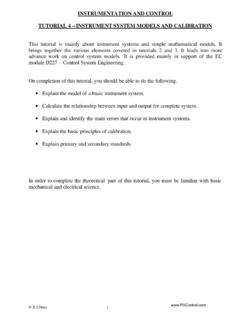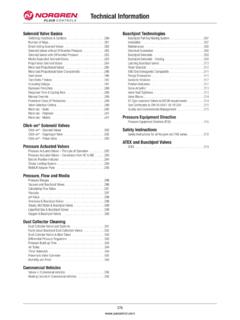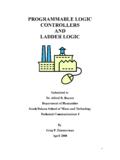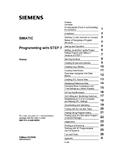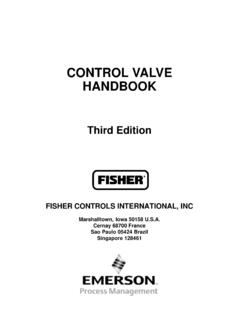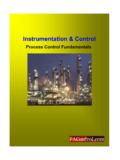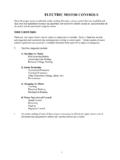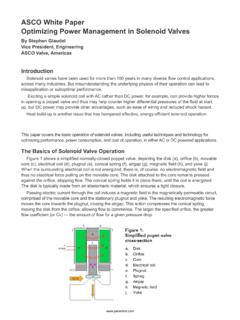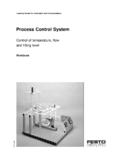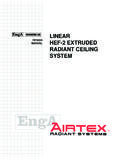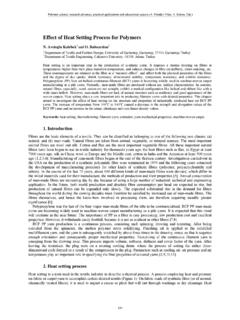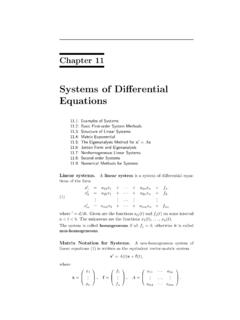Transcription of HEAT TRANSFER AND HEAT EXCHANGERS B which …
1 8 heat TRANSFER AND heat EXCHANGERS asic concepts of heat TRANSFER are reviewed in this chapter and applied primarily to heat EXCHANGERS , which are equipment for the TRANSFER of heat B between two fluids through a separating wall. heat TRANSFER also is a key process in other specialized equipment, some of which are treated in the next and other chapters. The three recognized modes of heat TRANSFER are by conduction, convection, and radiation, and may occur simultaneously in some equipment. CONDUCTION OF heat In a solid wall such as Figure (a), the variation of temperature with time and position is represented by the one-dimensional Fourier equation For the most part, only the steady state condition will be of concern here, in which the case the partial integral of Eq. ( ) becomes dT dx Q=-kA--, assuming the thermal conductivity k to be independent of temperature. Furthermore, when both k and A are independent of position, AT kA Q=-kA-=-(To-TL), ArL ( ) in the notation of Figure (a).
2 Situations often are cast. For example, Equation ( ) is the basic form into which more complex when the area is variable and Q = WW,,, ( ) in certain kinds of heat EXCHANGERS with variable temperature difference. THERMAL CONDUCTIVITY Thermal conductivity is a fundamental property of substances that basically is obtained experimentally although some estimation methods also are available. It varies somewhat with temperature. In many heat TRANSFER situations an average value over the prevailing temperature range often is adequate. When the variation is linear with which demonstrates that use of a value at the average temperature gives an exact result. Thermal conductivity data at several temperatures of some metals used in heat EXCHANGERS are in Table The order of magnitude of the temperature effect on k is illustrated in Example (C) 9 9 k = ko(l + aT), the integral of Eq.
3 ( ) becomes (e) (0 (8'6) Figure Temperature profiles in one-dimensional conduction of heat . (a) Constant cross section. (b) Hollow cylinder. (c) Composite flat wall. (d) Composite hollow cylindrical wall. (e) From fluid A to fluid F through a wall and fouhng resistance in the presence of eddies. (f) Through equivalent fluid films, fouling resistances, and Q(L/A)=kO[T,- T2+ (T:- T:)] =ko(Tl- TZ)[1+ (T,+ T+)], ( ) metal wall. 169 170 heat TRANSFER AND heat EXCHANGERS TABLE Thermal Conductivities of Some Metals Commonly Used in heat EXCHANGERS [kBtu/(hr)(sgft)W/ft)l Temperature ("F) Metal or Alloy -100 70 200 1000 Steels Carbon - I Cr t MO - 41 0 - - 304 - 316 - Monel400 Nickel 200 - lnconel 600 - Hastelloy C - Aluminum - 131 133 - Titanium Tantalum - - - Copper 225 225 222 209 Yellow brass 56 69 Admiralty 55 64 - - - - HOLLOW CYLINDER As it appears on Figure (b), as the heat flows from the inside to the outside the area changes constantly.]
4 Accordingly the equivalent of Eq. ( ) becomes, for a cylinder of length N, dT dr Q = -kN(2zr)-, of which the integral is ( ) This may be written in the standard form of Eq. ( ) by taking Am = 2xLNr,, ( ) and L=r2-rl, ( ) where EXAMPLE Conduction through a Furnace Wall A furnace wall made of fire clay has an inside temperature of 1500 F and an outside one of 300 F. The equation of the thermal conductivity is k = [1 + (E - 4)Tl Btu/(hr)(sqft)("F/ft). Accordingly, Q(L/A) = (1500 - 300)[1+ (E - 4)(900)] ~ If the conductivity at 300 F had been used, Q(L/A) = is the logarithmic mean radius of the hollow cylinder. This concept is not particularly useful here, but logarithmic means also occur in other more important heat TRANSFER situations. COMPOSITE WALLS The flow rate of heat is the same through each wall of Figure (c). In terms of the overall temperature difference, ( ) where U is the overall heat TRANSFER coefficient and is given by ( ) The reciprocals in Eq.]
5 ( ) may be interpreted as resistances to heat TRANSFER , and so it appears that thermal resistances in series are additive. For the composite hollow cylinder of Figure (d), with length N, ( ) With an overall coefficient U, based on the inside area, for example, 2nN( Tl - T4) Q =2nNr,U,(T1 - T4) = l/U,ri ' ( ) On comparison of Eqs. ( ) and ( ), an expression for the inside overall coefficient appears to be ( ) In terms of the logarithmic mean radii of the individual cylinders, -=ri[ 1 l+ l+ U, kormo/(r2 - rl) kbrmb/(r3 - r2) which is similar to Eq. ( ) for flat walls, but includes a ratio of radii as a correction for each cylinder. FLUID FILMS heat TRANSFER between a fluid and a solid wall can be represented by conduction equations. It is assumed that the difference in temperature between fluid and wall is due entirely to a stagnant film of liquid adhering to the wall and in which the temperature profile is linear.]
6 Figure (e) is a somewhat realistic representation of a temperature profile in the TRANSFER of heat from one fluid to another through a wall and fouling scale, whereas the more nearly ideal Figure (f) concentrates the temperature drops in stagnant fluid and fouling films. Since the film thicknesses are not definite quantities, they are best combined with the conductivities into single coefficients h = k/L ( ) so that the rate of heat TRANSFER through the film becomes Q = hAAT. ( ) Through the five resistances of Figure (f), the overall heat CONDUCTION OF heat 171 EXAMPLE Effect of Ignoring the Radius Correction of the Overall heat TRANSFER Coefficient The two film coefficients are 100 each, the two fouling coefficients are 2000 each, the tube outside diameter is ft, wall thickness is ft, and thermal conductivity of the metal is 30: Basing on the inside area, U, = [1/100 + l/2000 + [(30 )( )1-] + + ]-' = ri/ro = = , Ignoring the corrections, r, = ( - )/ln = , Uo = [1/100( ) + 1/2000( ) + 1/(30 )( ) rm/ro = , U = (2/100 + 2/2000 + 1/30 )-' = + 1/100 + 1/2000]-' = The last value is very nearly the average of the other two.
7 TRANSFER coefficient is given by ( ) where L, is the thickness of the metal. overall heat TRANSFER coefficient based on the outside surface is If the wall is that of hollow cylinder with radii r, and r,, the where r,,, is the mean radius of the cylinder, given by Eq. ( ). Since wall thicknesses of heat EXCHANGERS are relatively small and the accuracy of heat TRANSFER coefficients may not be great, the ratio of radii in Eq. ( ) often is ignored, so that the equation for the overall coefficient becomes simply 111 111 _=- +-+- +-+- u hi hz k3lL3 h, hs ( ) The results of the typical case of Example , however, indicate that the correction may be significant. A case with two films and two solid cylindrical walls is examined in Example EXAMPLE A Case of a Composite Walk Optimum Insulation Thickness for a Steam Line A 3 in. IPS Sched 40 steel line carries steam at 500 F. Ambient air is at 70 F.
8 Steam side coefficient is 1000 and air side is 3 Btu/(hr)(sqft)("F). Conductivity of the metal is 30 and that of insulation is Btu/(hr)(sqft)("F/ft). Value of the steam is $ cost of the insulation is $ (yr)(cuft). Operation is 8760 hr/yr. The optimum diameter d of insulation thickness will be found. Pipe: do = ft, d, = ft, In(do/di) = Insulation: In(do/di) = ln( ). (1) heat TRANSFER coefficient based on inside area: 1 +ln( ) 1 +3d] ' U,=di __ Q/Ai = UiAT = 430U,.. [lOOOd, + 30 Steam cost: C, = 5(10-6)(8760)Q/Ai = , $ (yr)(sqft inside). (3) 3 70 F 18 ! Example OPtimurn insul ation thickness 2r3 RERD D1 .* D2 38 DATR .2317,.2557 48 INPUT D 58 Ul=.BBl/DZ+. 1387/38+LOG( j/.85+1/3/D 68 U= 1 /U 1 lD2 78 @=4JB*U 89 C1=.8438tG! 98 CZ= *(Dn2-D1*2)/D2rr2 189 C=Cl+C2 ! (req'd to be minim Urn j c 118 PRINT USING 128 j DrU,Cl,C2> 1 28 I MRGE . DDD , X I . DUD , X DD . DD.))
9 X .. ,X, 172 EXAMPLE (continued) heat TRANSFER AND heat EXCHANGERS 2 D U c2 c1 + c ---- ,498 .354 ,494 .349 ,495 ,347 .496 346 .SO8 .?I41 Insulation cost: C, = ,/A, , $/(yr)(sqft inside). - (dZ- ) - ( ) (4) Total cost: (5) C = C, + C2+ minimum. Substitute Eqs. (2)-(4) into Eq. (5). The outside diameter is the key unknown. The cost curve is fairly flat, with a minimum at d = , corresponding to in. thickness of insulation. Some trials are shown with the computer program. A more detailed analysis of insulation optima is made by Happel and Jordan [Chern. Process Econ., 380 (1975)], although their prices are dated. Section also discusses insulation. heat TRANSFER coefficients are empirical data and derived correlations. They are in the form of overall coefficients U for frequently occurring operations, or as individual film coefficients and fouling factors.
10 MEAN TEMPERATURE DIFFERENCE In a heat exchanger , heat is transferred between hot and cold fluids through a solid wall. The fluids may be process streams or independent sources of heat such as the fluids of Table or sources of refrigeration. Figure shows such a process with inlet and outlet streams, but with the internal flow pattern unidentified because it varies from case to case. At any cross section, the differential rate of heat TRANSFER is dQ = U(T - T ) dA = -mc dT = m c dT . ( ) The overall heat TRANSFER rate is represented formally by T ,hot -<*+ , (AT), (AT), cold II II T Figure Terminal temperatures and temperature differences of a heat exchanger , with unidentified internal flow pattern. SINGLE PASS exchanger The simplest flow patterns are single pass of each fluid, in either the same or opposite directions. Temperature profiles of the main kinds of thermal behavior are indicated on Figure (a).
